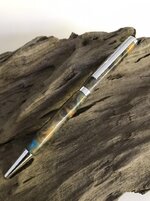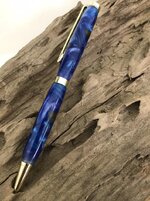@Jester4977
I bought this blank from woodturningz.com, and I have seen other blanks I've turned do this as well. I have seen others here talk about buying blanks from other members, how would I find members who sell blanks?
You asked about making contact with IAP members who make and sell pen blanks ...
Just keep an eye on the forums here. . People will advertise the fact when they have blanks to sell.
Just be aware that some member-made blanks look more professional than others. . You need to see pictures before you buy.
There are also plenty of nice blanks for sale by the various vendors that all of us order from. . If you need vendor names, send me a private message, or start a "conversation" with me and I can help you with that.
If you want to make contact with IAP members who make and sell blanks here are a few ways to do that.
There is something called "IAP Marketplace" under the "Forums" heading on the black bar above.
Within the marketplace, there is a forum called "For Sale".
And there is another called something like "Trades, Gifts, and Wants".
Some guys aren't too fussy where they put their ad, so you might find it in the general "Penturning" forum.
You could even write your own ad, as a "wanted to buy", if you want to.



